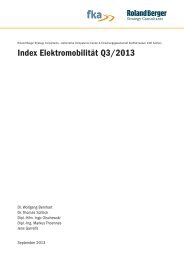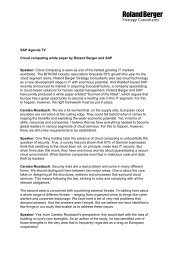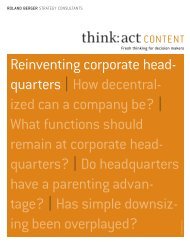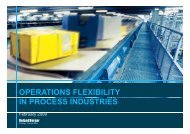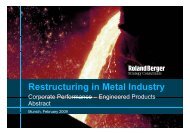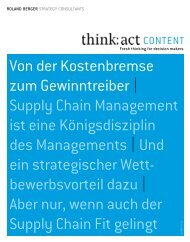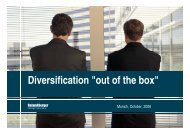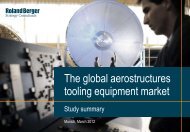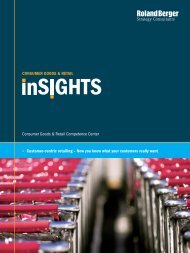"Automotive inSIGHTS 2/2010" (PDF, 3784 KB - Roland Berger
"Automotive inSIGHTS 2/2010" (PDF, 3784 KB - Roland Berger
"Automotive inSIGHTS 2/2010" (PDF, 3784 KB - Roland Berger
Create successful ePaper yourself
Turn your PDF publications into a flip-book with our unique Google optimized e-Paper software.
AUTOMOTIVE 2025<br />
Regional trade blocks such as MERCOSUR and ASEAN are<br />
expected to grow. This will mean a shift toward low-cost<br />
locations within those blocks. This trend will be accelerated<br />
by rising transport costs, political regulations and<br />
fluctuating exchange rates. Suppliers will follow the<br />
carmakers down this road.<br />
In the best case scenario, electric vehicles will account<br />
for up to 10% of all new vehicle sales by 2025. Their low<br />
range, heavy weight and high cost will limit their popularity.<br />
Hybrids will be more popular and reach a 40% share.<br />
PHEVs in particular combine the advantages of internal<br />
combustion engines with those of electric powertrains,<br />
without being dependent on the nearest charging point<br />
(which will still not be universal by 2025). Internal combustion<br />
engines will still account for 50% of new car sales.<br />
By 2025, many vehicles will always be online, sending<br />
and receiving information. Connectivity is a key factor<br />
here. Vehicles will communicate with one another and their<br />
environment, although we do not yet know exactly how.<br />
Google believes C2C and C2E communications will be<br />
integrated in cars via smart devices. The benefit of this is<br />
that new developments can quickly become widespread<br />
at low costs.<br />
QUOTE: Dr. Wieland Holfelder, engineering director at<br />
Google: "[….] we believe that by 2025, all vehicles will<br />
be always online, either directly or via equipment passengers<br />
bring with them, via 3G and 4G mobile phone<br />
networks.<br />
In other words, most data for infotainment and IT services<br />
that are not real-time-critical will be shared online by that<br />
time. The future is in Internet-based applications." However,<br />
many other people we spoke to do not think it makes<br />
sense to integrate safety-enhancing C2C and C2E applications<br />
via an interface between a vehicle and a smart<br />
device. OEMs could find themselves liable if clean connections<br />
cannot be made between vehicle and device (if their<br />
iPhone crashes or is hacked into, for example). They prefer<br />
to integrate safety-critical C2C and C2E functionalities at<br />
the factory, which would push back the market launch until<br />
well after 2025. The widespread usage of such functions<br />
would also be delayed.<br />
The idea that cars of the future – connected via intelligent<br />
traffic solutions – will have fewer accidents and that the<br />
weight and cost of active and passive safety features<br />
could therefore be reduced, is not likely to become reality<br />
until well after 2025. Perhaps the concept could be<br />
piloted in one of the new megacities that will have been<br />
created by then – if city planners design a corresponding<br />
strategy (for electric vehicles only) for the city center.<br />
The trend of "demotorization" will first emerge in the big<br />
cities of established industrial nations. People in the new<br />
megacities, almost all of them in Asia, will find their values<br />
changing rapidly. Even today, car ownership rates are fairly<br />
low among the under-30s, and will decrease further by<br />
2025. And the cohort effect means the next age group will<br />
follow these behavioral patterns, even if they do not need<br />
to financially.<br />
15



